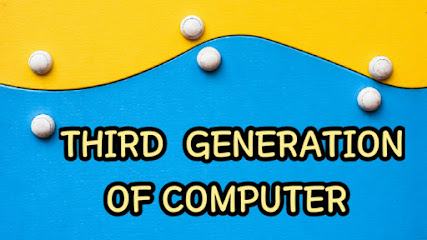Hello everyone , in this blog we will learn about generations of COMPUTER .
INTRODUCTION :-
Computer is an electronic device which takes input from user , process it and deliver output according to the given instructions .
As we all know the importance of computer in this modern time . There are several works which has worked on computer in a very short extent of time and less amout of effort . But are you know , there are a huge history behind the devolopment of computer , to reach at the present time from the past .
Different computing device developed over the years can be categorized into several generations . Each generation comes as a result of huge technological development which changed the working principal ( way ) of computer used to operate . As we proceed from one to another generation , we will see that --
- Size of computer decreases . ( smaller )
- Cost of computer decreases . ( cheaper )
- Computing capacity increases ( efficient )
- First generation ( 1946 - 1959 )
- Second generation ( 1959 - 1965 )
- Third generation ( 1965 - 1971 )
- Forth generation ( 1971 - 1980 )
- Fifth generation ( 1980 - till omwards ....
FIRST GENERATION OF COMPUTERS :-
The very disvantange of computer was it's size . A single computer was used to cover the space of entire room . Since it is very large , so it consume high amount of electricity and generate a very high amount of heat . Apart from these , there were also many types of technical faults and problems which requires proper maintenance at regular intervals .
This generations of computer belongs to machine language and used to perform operation one at a time . There were punch card and paper tapes which used to take input and display the output on paper as printout .
Examples of this generation's computer :- ENIAC , EDVAC , UNIVAC etc....
SECOND GENERATION COMPUTERS :-
Second generation of computers used assembly language instead of machine language which helped the programmer to express their instructions in words .Main advantage of this generation's computer was that they were able to store the program in the memory of computer . Here also , Punch card and magnetic tapes were used to accept input and store output either in punch card or printed on a paper . These computers used magnetic tapes and magnetic disks as external storage devices .
Example of this generations of computer :- honeywell 400 , IBM 7094 , CDC 1604 , CDC 3600 etc .....
THIRD GENERATION OF COMPUTER :-
These computers used a keyboard , for accepting data from the user and display the output on the monitor . Here , keyboard is an input device and monitor is an output device . The cost of computers are decreases in such a extent that they were affordable by a large part of common population .
Examples of this generation's computer :- IBM 360 , IBM 370 , ICL 2900 , PDP 8 etc....
FORTH GENERATION OF COMPUTER :-
The forth generation of computers were based on microprocessor . It is categorised by the use of Large Scale Integration ( LSI ) and Very Large Scale Integration ( VLSI ) .The main change in this generation was seen in replacement of magnetic core memories by semiconductor memories . A very familiar example of this generation computer is Personal Computer ( PC ) .
These computers are much smaller and cheaper than the computers of the previous generation . They were more reliable and consume very less amount of energy . They had larger primary and secondary memory to store huge amount of data . They need very less maintenance . All type of high language can be used which allow the users to execute their program from one computer to other .
There are only main disadvantage is that, due to presense of ICs in may cases , it required air conditioning .
Examples of this generation's computers :- IBM 4341 , STAR 1000 , etc .......
FIFTH GENERATION OF COMPUTER :-
This computers are portable , have smaller size and high computing efficiency . User can even use them while traveling . There are no any type of requirement like air conditioning . These computer provides user friendly interfaces with multimedia features which help in making the system more useful in every occupation .
Examples of this generation's computer :- Desktop , Laptop , Notebook etc .....
Visit my previous blog an learn with better content and knowledge . You all are requested to must follow my instagram page .
stay tuned !








Comments
Post a Comment